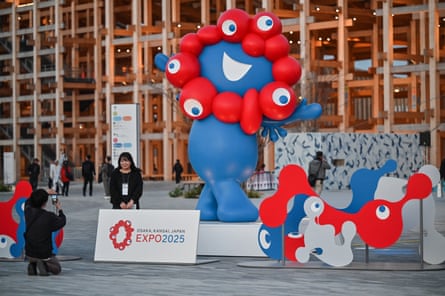The six-month international exhibition featuring 150 countries and regions launches with hopes to foster global cooperation through innovative architecture, cutting-edge technology, and cultural exchange
Japan has officially opened the gates to its ambitious World Expo 2025 in Osaka, marking the country's second time hosting the prestigious event in 55 years. Set on a transformed 960-acre reclaimed island aptly named "Dream Island," the six-month exhibition aims to showcase technological innovations and promote international unity under the theme "towards a brighter future for all" despite ongoing global conflicts and economic tensions.
Architectural Innovation at the Heart of Expo 2025
The most striking feature of the Expo is the Grand Ring, a massive circular wooden structure designed by renowned Japanese architect Sou Fujimoto. Spanning a 2-kilometer circumference and rising 20 meters high, this lattice-like wooden marvel is recognized as one of the world's largest wooden structures and symbolizes the event's concept of "Unity in Diversity" Dezeen1.
"The whole global situation is very unstable," Fujimoto told reporters, acknowledging the challenging global context. "But I believe this is a really precious opportunity to show so many countries can come together in one place and think about our future together" The Guardian2.
The Japan Pavilion, designed by Nikken Sekkei Ltd, exemplifies the innovative architectural approach with its circular form achieved through a radial arrangement of cross-laminated timber (CLT) panels. The structure employs a steel frame core with exposed CLT components that act as seismic-resisting elements, showcasing both aesthetic appeal and practical engineering solutions ArchDaily3.
Global Participation Amid Challenges
With 150 countries and regions participating, the exhibition presents a kaleidoscope of cultural and technological presentations. Pavilions range from the flamboyant architecture of Turkmenistan to Japan's neat wooden designs, housing extraordinary exhibits such as a Martian meteorite discovered in Antarctica, interactive androids, and a beating artificial heart made of stem cells The Guardian2.
However, not all participants were fully prepared for the opening day. Several pavilions, including those of Nepal and India, were not completed in time for Saturday's launch. Political conflicts have affected preparations for Ukraine and the Palestinians, while Russia opted not to participate at all AP News4.
Political Leaders Call for Global Unity
Japanese Prime Minister Shigeru Ishiba used the opening ceremony to emphasize the Expo's potential for fostering international cooperation. "It is extremely meaningful that people from around the world gather to discuss the theme of life and experience cutting-edge technology, diverse ideas and culture," he remarked, expressing hope that the event could help restore global unity in a world plagued by conflicts and trade wars AP News4.
Emperor Naruhito, who attended the previous Osaka Expo as a 10-year-old prince in 1970, also addressed the gathering, reflecting on Japan's long history with world expositions and expressing his hopes for the event's success.
Financial and Logistical Hurdles
The path to the Expo's opening has not been without significant challenges. Construction was hampered by labor shortages and soaring material costs, causing the project's price tag to nearly double from the initial estimate of ¥125 billion to ¥235 billion (approximately $1.25 billion) The Guardian2.
Public interest has been somewhat lukewarm, with only 9 million advance tickets sold against a target of 14 million. Nevertheless, organizers remain optimistic about achieving their ambitious goal of attracting more than 28 million visitors by the time the event concludes on October 13 AP News4.
Sustainability and Innovation Showcase
The Expo demonstrates Japan's commitment to sustainability and circular economy principles. The Japan Pavilion exemplifies this approach through its use of CLT panels designed for disassembly and reuse after the exhibition closes. Additionally, the pavilion features an integrated biogas plant that converts food waste from the Expo grounds into electricity, reducing environmental impact while showcasing renewable energy technologies ArchDaily3.
Other innovative pavilions include the USA Pavilion, which features two triangular buildings with a wooden facade and large LED screens displaying American landscapes and cultural scenes Expo 2025 Official Website5.
Future Implications for Global Cooperation
The Expo opens at a time of significant global tension, with ongoing conflicts in Ukraine and the Middle East, as well as rising trade disputes. Recent tariff threats from U.S. President Donald Trump have added to the uncertainty, potentially dampening the celebratory atmosphere AP News4.
Despite these challenges, the event represents a significant investment in cultural diplomacy and international cooperation. Through its theme of "towards a brighter future for all," the Expo aims to create a space where nations can showcase their innovations and cultural heritage while engaging in dialogue about shared global challenges.
The architectural centerpiece—Fujimoto's Grand Ring—physically embodies this aspiration by creating a unified structure that encircles and connects diverse pavilions, much as the Expo itself seeks to bring together different nations in pursuit of common goals.
As the world grapples with political divisions, climate change, and technological disruption, can this six-month celebration of human achievement and creativity truly help bridge our deepening divides, or will it remain a well-intentioned but ultimately symbolic gesture in an increasingly fractured global landscape?




